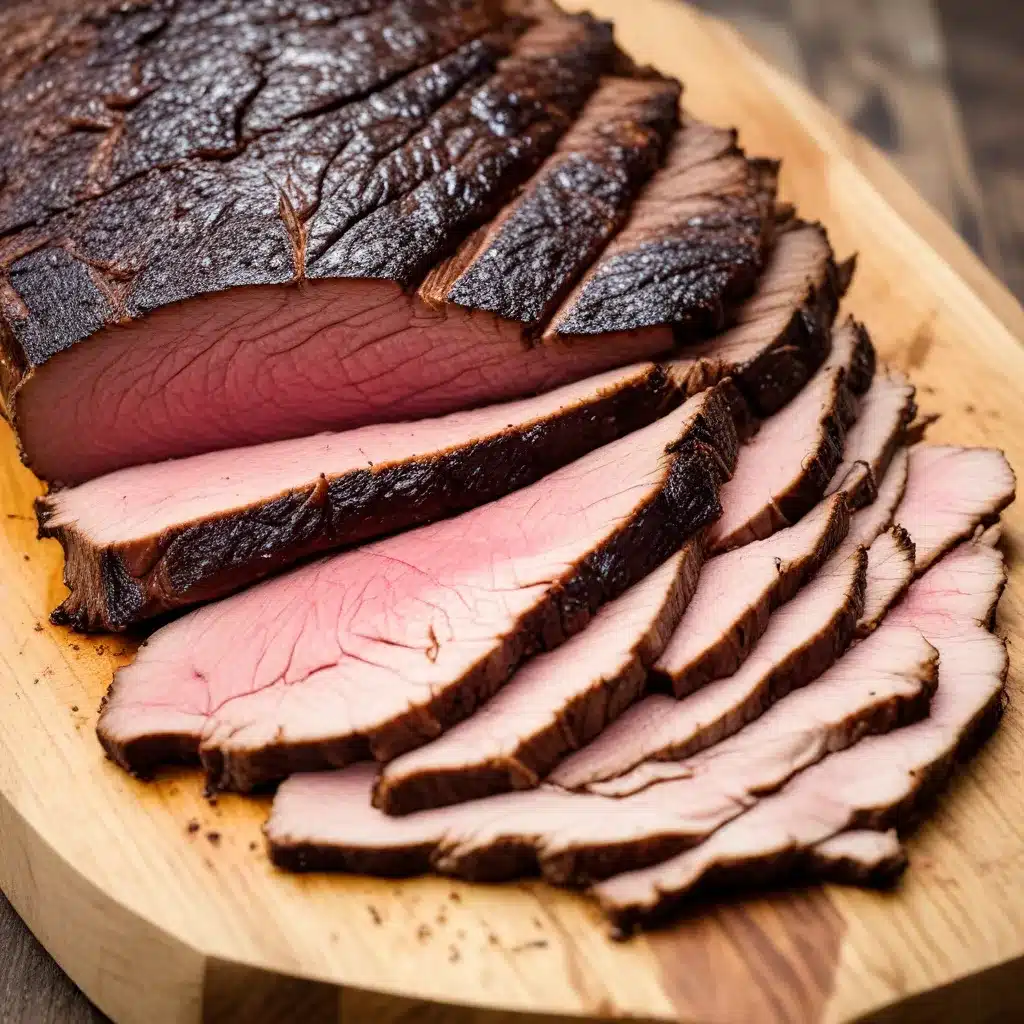
As an experienced barbecue pitmaster, I’ve dedicated countless hours perfecting my brisket recipe and technique. At Creekside BBQ, we take great pride in our smoked brisket, which has become a signature dish that keeps our guests coming back time and time again.
The Art of Brisket Preparation
Preparing a brisket properly is the foundation for achieving that melt-in-your-mouth texture and deep, smoky flavor. First and foremost, selecting the right cut of meat is crucial. I always recommend going with a whole packer brisket, which includes both the flat and the point. This gives you the perfect balance of lean meat and tender, well-marbled sections.
When trimming the brisket, I like to leave a thin layer of fat on the surface, around 1/4 inch thick. This fat cap will render down during the cooking process, basting the meat and helping to create that signature bark. I start by removing any large, thick chunks of fat, as well as the thin, papery membrane on the underside. This allows the rub to penetrate into the meat more effectively.
Seasoning for Maximum Flavor
For the seasoning, I prefer to keep it simple yet impactful. My go-to rub is a blend of coarse kosher salt and freshly cracked black pepper, with a touch of garlic powder and cayenne for a little kick. I’ll generously season the brisket, making sure to get the rub into all the nooks and crannies. Some pitmasters like to let the seasoned brisket rest in the fridge overnight, allowing the salt to work its magic and draw out moisture, which then gets reabsorbed. This can help develop an even more flavorful and tender end product.
While there’s certainly room for creativity when it comes to brisket rubs, I find that the classic salt-and-pepper combination allows the natural beef flavor to truly shine. Of course, you’re welcome to experiment with your own spice blends, but I’d suggest starting with the basics and then gradually building upon them to find your perfect flavor profile.
The Low and Slow Smoking Process
Now, let’s talk about the cooking process. Brisket is one of those cuts that really benefits from the low and slow method, where you smoke the meat at a relatively low temperature (around 195-250°F) for an extended period of time. This gentle, indirect heat helps to break down the tough connective tissues, transforming the brisket into a tender, juicy masterpiece.
I like to start my briskets at 195°F for the first few hours, allowing the meat to slowly take on that beautiful smoke flavor. Once the internal temperature reaches around 150-160°F, I’ll wrap the brisket in butcher paper or foil to help it power through the notorious “stall” phase. This stall can last for hours, as the meat’s internal temperature seems to plateau, but wrapping helps to push it through and keep the moisture locked in.
After the wrap, I’ll increase the temperature to 250°F, letting the brisket continue to cook until it reaches an internal temperature of 200-205°F in the thickest part of the flat. This is the sweet spot where the connective tissues have fully broken down, and the meat practically begs to be sliced.
The Importance of Rest and Slice
One of the most crucial steps in the brisket-making process is the final rest. I always let my briskets rest for at least 2-3 hours, sometimes even longer, after they come off the smoker. During this time, the juices redistribute throughout the meat, resulting in that signature moist, tender texture.
When it’s time to slice, I like to go against the grain of the meat, which helps to create those beautiful, tender slices. I find that slicing at a slight angle, rather than straight across, also helps to maximize the tenderness and juiciness.
Flavor Combinations and Serving Suggestions
At Creekside BBQ, we love to serve our brisket the traditional Texas way – naked, with just a few slices of white bread and a drizzle of our house-made barbecue sauce on the side. This allows the true flavor of the meat to shine without any distractions. However, I know that some folks enjoy experimenting with different accompaniments.
One of my favorite pairings is to serve the brisket with a side of creamy, tangy coleslaw and a heaping portion of our signature barbecue beans. The cool, crunchy slaw provides a nice contrast to the rich, smoky brisket, while the sweet and savory beans complement the dish perfectly.
Another tasty option is to incorporate the brisket into tacos or fajitas, layering the tender meat with fresh pico de gallo, guacamole, and a sprinkle of queso fresco. The versatility of brisket makes it a fantastic centerpiece for all sorts of Tex-Mex-inspired dishes.
Mastering Your Brisket Technique
Perfecting brisket takes time, patience, and a whole lot of practice. But I can assure you that the effort is well worth it. Whether you’re a seasoned pitmaster or just starting your barbecue journey, I hope these tips and insights have inspired you to take your brisket game to new heights.
Remember, every brisket is unique, and what works for one cook may not work for another. The key is to experiment, keep an open mind, and most importantly, have fun with the process. After all, the true joy of barbecue is in the journey, not just the destination.
So, fire up your smoker, grab a cold beverage, and get ready to create some truly mouthwatering brisket masterpieces. I’ll be right here, cheering you on and sharing more of my barbecue wisdom along the way. Happy smoking, my friends!

